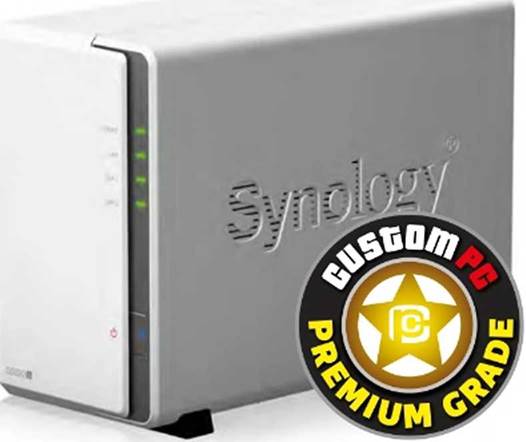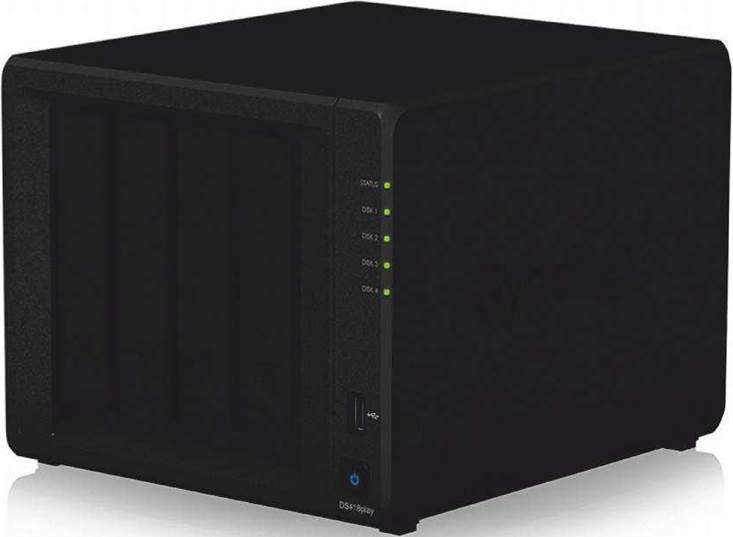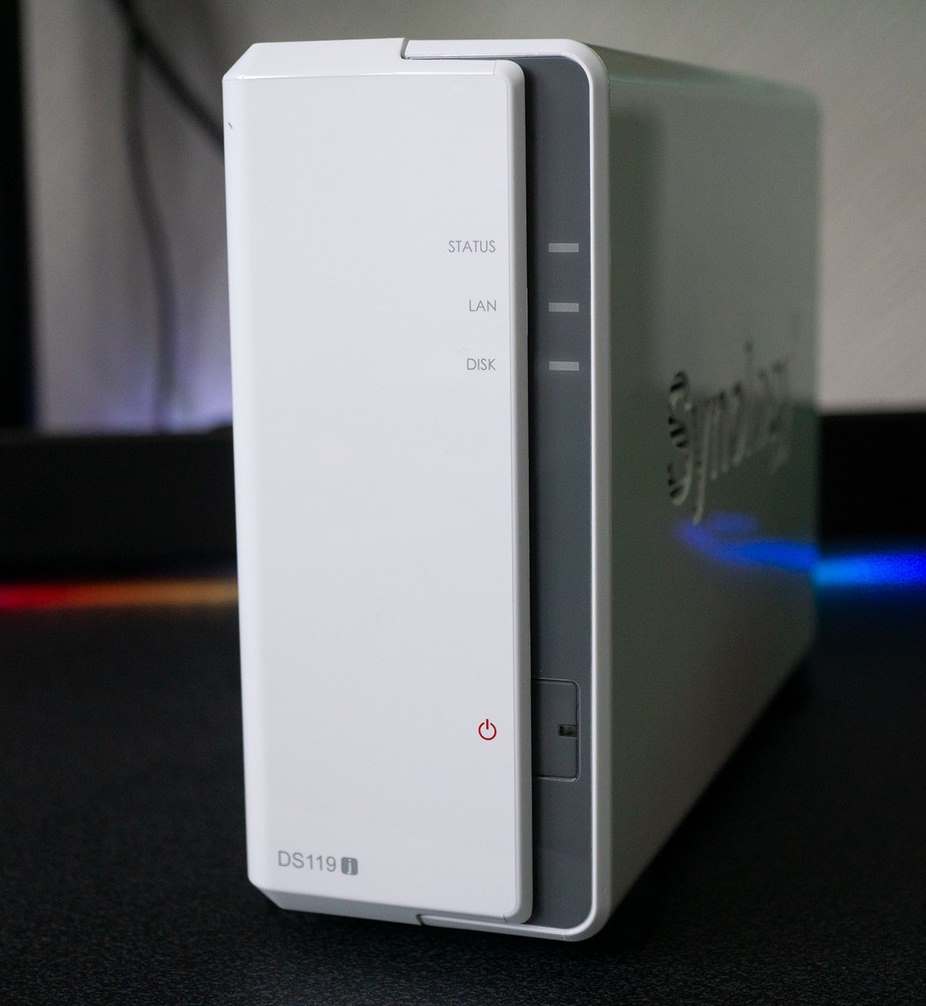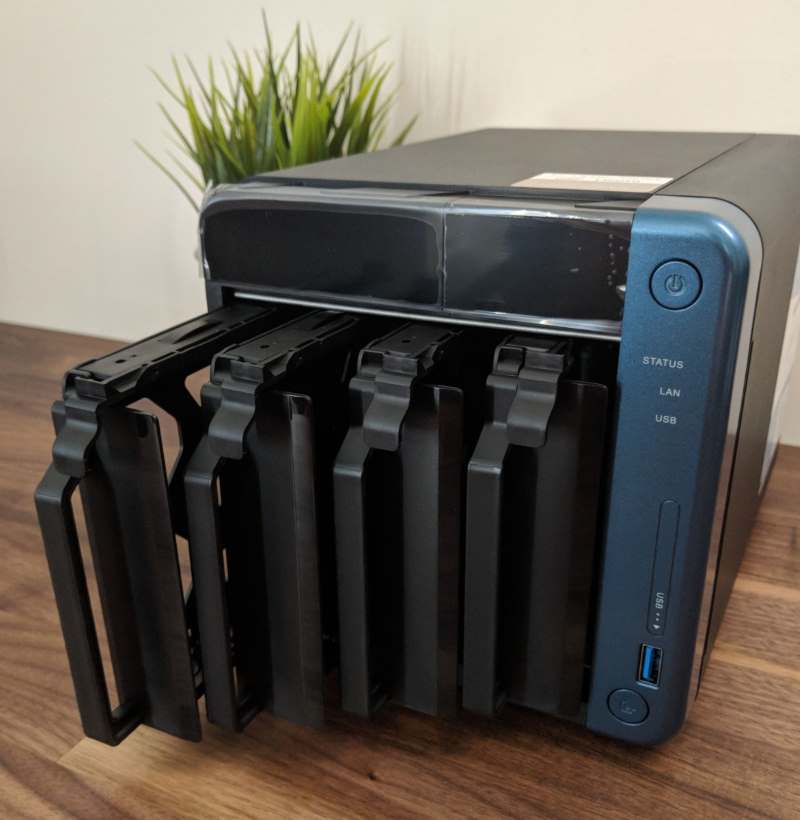“After some 10 minutes it was clear that whatever was happening with the original unit was happening here’’
JON HONEYBALL
A blue light of death causes problems in Jon’s much-loved synology NAS drive, while a pair of smart earphones prove not to be so smart after all
Table of Contents
I know we’ve all heard of Blue Screens of Death. No doubt, dear reader, you’ve suffered them over the years when Windows decides to have a kernel panic and throw all of its toys out of the pram. But a blue flashing LED of death is a new one. And it was the starting point of quite a lot of wasted time.
First, the back-story. I love NAS boxes, especially the units from Synology. I know others swear by QNAP and other vendors, but Synology satisfies all of my requirements. I have small units for IP camera storage and backup.
I have another pair for music-streaming. And I have two large ones for data backup in the lab.
They’re not primary storage, but secondary units. However, I love the range of capability that I get with them – a solid file system, plus support for cloud backup and archive solutions such as Dropbox and Backblaze. And the ability – with the bigger units, at least – to replicate parts of the file system between boxes. Not only that, but you can keep snapshots of the file system, which allows me to roll back to previous versions of terabytes of data at the click of a mouse.
The UI is pretty comprehensive and obvious, the menus work, and they’re pretty much a low-stress solution. This is the reason I have two. One is a 12-drive unit, with a five-drive expansion cage. The second, the hero of our story, is a 12-drive bay unit filled with 8TB hard disks and a pair of SSD drives in RAID.
So about this blue LED issue. When it flashes fast, it tells me that it’s sorting out its hair and makeup, and getting ready to strut its stuff on my network. It does this after booting, and before connecting to the LAN. This is normally fine, because the blue flashy period typically lasts for around a minute. Then the first LAN light comes on as a Gigabit Ethernet connection is made, and the status LED lights up in orange while everything is checked out. Finally, the status LED goes green and the blue flashing LED stops flashing. All very simple; all very easy to use.
Right up until the point where the blue LED stays flashing and the first LAN line stays resolutely dark. Now at this point, you really have no idea what has gone wrong. There’s no UI; there’s no display panel. You can’t connect to it over the LAN because the LAN is disconnected. It doesn’t even throw out a plaintive beep sequence to provide a clue.
A trip to Google reminds me that Intel had an issue with the Atom processor that meant it could randomly die. This affected Synology boxes made up to about a year ago when the fault was found.
I don’t know what the conversation was like between Synology and Intel, but I can guess it was fairly
▲ When the blue light in the bottom corner of your Synology won’t stop flashing, you know you’re in trouble
brutal.
I raised a support ticket through the Synology website describing the issue. I also wrote an email to Synology’s PR team. Almost immediately, Synology support sprung to life and informed me that my box had probably died, and that they’d overnight me a replacement together with an RMA to return the offending dead item back to them.
At this point, there was nothing left to do with it, so I went to the pub.
The next morning, our UPS chappy dropped off the new unit and took away the old one. I put all 12 of the drives into the new unit in the correct order and pressed the power button. The blue LED started flashing… and continued to flash. After some ten minutes, it was clear that whatever was happening with the original unit was happening with this one. I wrote an update email to Synology.
Then I decided to try a few things. First, I tried only connecting one Gigabit Ethernet cable to the box, because I was running four in a bonded arrangement. That didn’t work. I pulled out all the drives and powered up the box. It booted, in a fashion, and I could connect to it across the network. I updated Synology via email. Then I took a spare 10TB hard disk, mounted it into the drive cage carrier, and popped that into slot 1. It booted and offered to set up the NAS for me. This seemed a good idea, because it really isn’t clear where Synology actually holds its boot information.
Is it in NVRAM? Is it on the disks? This isn’t obvious from the documentation.
Hallelujah – a miracle had occurred! The NAS was up and running. But it had one 10TB hard disk rather than my 80TB RAID. I shut it down and updated Synology via email.
I found some instructions that told me now would be the right point to pull out the fresh disk and put my array back in place. I tried it.
I got the blue blinking LED of death for ten minutes.
I decided to be sneaky. I put the hard disks of my array into the NAS, offset by one slot, thus allowing the fresh 10TB to sit in slot 1. So my drive 1 was in slot 2, drive 2 in slot 3, and so forth. This doesn’t allow me to load up the cache, but it’s only cache so it shouldn’t matter, should it?
The unit booted, and I could see my RAID array. This pleased me greatly. But it was covered with all sorts of nasty errors about the cache being absent. I told it to sort itself out. I updated Synology via email.
Finally, I pulled the 10TB disk and moved my array back by one slot. Many jokes were made at this point about “Option Base 1”, which is a very old programming joke that hopefully none of you will understand.
I powered up the NAS and – mercy be – it booted. My data was present, but my account information appeared to be toast, and my 2FA login had gone. In addition, most of my services were missing, too, so file system replication was broken. Nevertheless, it was up and running – in a manner of speaking – and now I could start to fix the mess.
I updated Synology via email, informing the company that it was now mostly working.
At this point, I’d sent eight emails on day two to Synology and not had a response. Mildly miffed, I pointed this out to the PR team. Almost
▼ When one Dell XPS all-in-one dies, it’s only sensible to buy a new one
immediately I received a response from them and the support staff.
Two days on, I’m still sorting out NAS to NAS replication. Do I know what happened? No. Might it have been the Atom issue? Maybe, I have no way of knowing. Am I happy with the recovery process? Right now, I’m in two minds. Firstly, it ought to be possible to find out what is going on, but it’s baked into the design that nothing works until the network interface starts up. I did recover my data, and that’s a good thing. But you should never be in a position where failure of a device causes data loss. If you are, then more fool you.
I guess I just hoped that the “move drives to new box and hit the power button” had worked better and that it was less of a ballache. Do I still like my Synology boxes? Yes, of course. Am I glad I have more than one unit storing important data? Absolutely.
GDPR IN THE MACHINE
You have to laugh. In all the nonsense and email storms about GDPR compliance, the good people at Ghostery sent out an email to customers informing them all about the company’s position on GDPR, and how everyone is being really responsible. I received it, as a Ghostery enthusiast and customer.
Except for one issue: instead of using BCC for the mass emailing, it used CC. So I got a long list of Ghostery customers on my email, and they got my email address – on an email about GDPR. No, you couldn’t make it up. I’ve asked Ghostery to ask its legal team for a comment, just because I’m feeling naughty. (Update: Ghostery has put out a fulsome apology. Full marks, at least, for recognising what it has done wrong.)
Last month I detailed my tale of woe regarding my old Dell XPS all-in-one desktop, how it died, and then how I used it hooked up to a Surface Book. It was a marriage made in hell, and it simply wasn’t going to last.
The obvious solution was to get another computer. I tend to like the Dell products, so trundled over to its website. A new Dell XPS 27 seemed just the job. Intel i7-7700 processor running at 3.6GHz, 32GB of RAM, 1TB SSD, a decent AMD RX 570 graphics card with 8GB of RAM, and a 4K display.
The XPS 27 arrived within a few days, and I set it up. Almost immediately, I had to do a Skype call with some clients, so I thought my shiny new Dell would be ideal. Only then did I discover that the front-facing video camera sits below the screen, right down by the keyboard. It gave an excellent view of my manly torso and chiselled facial features, but precious little of anything else.
For a moment, I gave serious thought to whether I mounted the Dell the wrong way up on my desk. But no, it really is designed to work that way. I have no idea what the thinking process was at Dell that resulted in this design decision. Where someone said, “I know, I’ve got a great idea: Why don’t we make the webcam look at everyone’s stomach?” Truly, my mind boggled.
I moved on to the inevitable full update that the system required, which took the usual few hours.
Dell has a tool called SupportAssist that checks drivers, hardware, and that carries out various tune-up tasks. I was somewhat amused to see it reporting that my PC hadn’t been optimised in the past 464 days. As I doubt not a single component of the computer existed 464 days ago, this didn’t come as a surprise. Although I’m left to wonder who tested this code.
As a brand-new machine, I thought it would be wise to have some sort of rapid recovery mechanism. So I decided to give Acronis True Image 2018 a whirl.
It’s been a while since I used True Image, so a refresh of its capabilities seemed in order. I popped a USB 3 external hard disk into a spare socket, fired up the software, and told it to go ahead and make a full image backup.
I confess I haven’t yet done something that I consider to be an non-negotiable task – if you run imaging software, then you absolutely must try it out to prove it works. And do this in plenty of time before disaster strikes. The point at which you have to recover a smoking wreck of a computer isn’t the best time to discover that your imaging solution has some playful issues. I haven’t done this yet, but will do in the next few weeks.
So far, True Image 2018 has impressed – except for one thing.
It runs a process called Acronis Active Protection, which claims to stop ransomware from making mass changes to data files on your hard disk. All of this seems a good idea, except it threw a large wobbly when Dell SupportAssist decided to update itself, reporting that 1,256 files were affected. Fortunately, a quick scan of the log showed the offending files to be in the C:\ Program Files\Dell\SupportAssist\ folder, so nothing was actually going badly wrong. It might be nice if the two products played together in a more harmonious fashion, though.
SENNHEISER SMART AMBEO HEADSET
I’m a huge fan of Sennheiser products. The company has a strong reputation in the headphone world for delivering excellent products and a superb service. It’s also one of the few vendors that actively has a spare parts process in place for when you inevitably break them.
I was intrigued by its new Smart Ambeo headset, which combines in-ear headphones with high- quality microphones built into each ear capsule. The idea is that you can record what’s happening around you: this could be a crowd scene, or at a concert, or anywhere you want to record.
Since they’re in- ear, they create a “binaural” recording, which can provide a very realistic sense of surround, including height.
I had a particular, somewhat odd requirement. I’m doing some research into the efficiency of in-ear hearing protection for motorbike users. I have the GRAS IEC reference Ear & Cheek Simulator, and have been using a near-field loudspeaker to generate pink noise to act as the noise source.
That’s fine, but the noise you get in your helmet – road noise and wind – isn’t pink at all. It has a much more low and mid-frequency than high frequency.
So it seemed to make sense to have an understanding of what the frequency shape actually is in practice. The Ambeo headset seemed ideal for this; pop them into my ears, on with the helmet, hit record and off we go. I could then get a pretty reasonable representation of the real noise shape.
I quickly started running into issues. First, Sennheiser doesn’t provide an app through which to do the recording, but recommends Apogee MetaRecorder. No problem, I downloaded it. I assumed it would just work, with the Ambeo headsets acting as a dongle because they connect via a Lightning cable to my iPhone. But no. MetaRecorder will record only 60 seconds of stuff until it stops. Unlocking this costs money.
Next, it seems that there’s no record level control. There’s basically high and low, and that’s it. High seems super-sensitive, so low is needed most of the time. But there is no fine-tuning.
Even more annoying is the provision of active noise cancellation. Like you, I’m used to getting on a plane, firing up my noise-cancelling headphones, and dozing off into a quiet slumber.
Turning noise cancellation on and off appears to do almost nothing with Ambeo. I even measured it on the GRAS test rig.
I raised the issues with Sennheiser technical support, and went around the houses a few times. I’ll report back when I hear more – no pun intended.
– Sennheiser’s Smart Ambeo headset is a curious thing, so I hope my replacement set works – the first pair certainly didn’t






Hi, I just want to thank you for your writeup on the Synology. You just saved me $1000 by merely suggesting to remove the drives and stick them back in a different order.
I had the blue power led issue on my DS415+ also. When I removed all disks the system booted but when I put in 1 or more disks the systems got the blue blinking led again (not one of the other leds (green or orange) lighting up.
So after trying all kind of things I read on the web which did not solve the problem and after a long time of thinking I thought might this be an issue with the power supply. I had a spare one from an old DS411j which I connected and …. my system was running again.
I had similar issue with my DS1815+.
Here’s what worked for me.
LSS:
Try to use only one of the memory slots at a time, one of them might be toast, it may be the card or a fault on the motherboard. Mine was the second case, so the unit boot up with only one memory card in the internal slot.
I’m done with Synology, already moving to UnRaid, do yourself a favor and build your own server that can be easily fixed when it gets broken (or upgraded cheaply when you need to).
LS:
Mine was already a second unit, a new one replaced by Snology while my previous one was still under warranty (motherboard failure). Second time warranty was over!
After trying to open the unit for the solder fix, I discovered that the replacement unit already had the resistor soldered on. So I erplaced the CMOS battery while it was open and still nothing.
But after running into some messages about Blue Blinking Light of Death caused by incompatible RAM (like this https://www.reddit.com/r/synology/comments/fezcgo/ds218_memory_upgrade_blinking_lights/), I thought I might as well try to remove one memory card each time. Note that my memory wasn’t incopatible, and I’ve been running the system with them for years, both in my original and replacement units.
So I first tried to remove the external memory card, and the system booted just fine.
Put the memory back, failed to boot again.
I wanted to check if was the memory card or the motherboard, so I put the card I had in the internal slot in the external one (only one card), still no go. Tried the external card I removed in the internal slot (only one card), worked again. Testing a single card with the original memory the unit came with gave the same results. The motherboard was toast again, luckily, not in an unrecoverable way.
I’m not waiting for the motherboard to fail completely, already built an UnRaid server and am almost done copying all my data from the now working Synology to it. The customer service wasn’t great when I still had waranty, and absolutely horrible once it was over. I’m not buying into Synology again.
I want a simple solution that I can fix easily with an off the shelf component when something breaks. Not looking for soldering fixes with resistors and spare parts that practially don’t exist anywhere if you don’t have waranty.
thanks for your information.
I upload to firmware diagnostic bios and see result use post code card. So I found what RAM memory have failure. (3 long bling and 4 short)so I replaced it and now it works good. Possible to find out other issues with power and stability. so test bios ROCK!
Option Base 1 – sounds like Quick Basic 🙂 age check passed